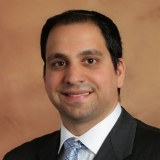 It started out like a regular clinic day.
It started out like a regular clinic day.
I had a busy morning of clinic patients. As I sat across my 9 a.m. patient in the exam room, we chatted briefly about our families, then I asked my usual history and review of ophthalmic pertinent symptoms. He noted everything was great and his vision was very stable.
As I scooted towards him with my chair to the slit lamp microscope, I noticed he still had his glasses on. I kindly requested that he remove his glasses for the exam. He took them off, looked around a bit, and finally placed them very inconveniently in front of my slit lamp joystick. If I had started to use the microscope, it would have crushed his glasses. Quickly, he realized that it was not an appropriate place for the glasses and then decided to quickly take them and try to put them on the side table. Unfortunately, in his haste, the glasses missed the table and fell to the floor. We both looked at each other and he said, “Well, where should I put them?”
Identify a Problem and Develop a Solution
That’s when it hit me: there should be a place that patients can place their eyeglasses safely and securely during the slit lamp microscope examination. I still had a busy clinic of patients, so I continued working but could not shake off the euphoria of inspiration. As I continued seeing more patients, I noted very similar scenarios like the first patient interaction. Although there were slight variations, there was a single underlying theme: patients have no place to place their eyeglasses during the examination. I observed them putting the glasses on the side of the slit lamp, in front of it, inconveniently giving the glasses to a family member, dropping the glasses, and even smashing them in their pocket! I realized this was a problem I encountered on a daily basis in my practice, and that many ophthalmologists probably were, too. With this in mind, I came to the realization that I had an opportunity to help my patients in more than just being their doctor. I could use my scientific ingenuity to solve more problems than just their eye conditions.
As I returned home, that inspiration evolved into a true idea: designing an eyeglass holder that could attach to the table of the slit lamp microscope (or frankly, any table). I sat at my desk and sketched out the first prototype. From this, I went to my local hardware store to gather the raw materials and dusted off my toolset to produce the first prototype of my eyeglass holder.
Patent Your Idea and Develop Your Manufacturing Process
After I ensured that my idea worked as I expected it to in its utility and function in the clinic, I patented the idea. The next step in the journey (and probably the most daunting, originally) was developing the manufacturing process. There were a few principles I wanted to uphold during this process: it had to be manufactured in the U.S, and I wanted to make sure it would be affordable for the public. After considerable efforts, I located a manufacturing facility just 10 miles from my home.
Create a Company Infrastructure and Strategic Marketing Strategy
Now that I had a viable product, the final portion of my journey was setting up a company officially. From this, I developed my e-commerce website and now sell the product online directly to consumers. In addition, I am exploring potential licensing opportunities and international distribution strategies. What started out as inspiration in clinic one day has now become a true industry with retail sales and a patented product.
Always Keep in Mind What Is Important to You
Throughout the whole journey, my greatest inspiration, motivation, and support have been my lovely wife Yasmin and my amazing daughter Julia. Yasmin helped me with essentially every step of the process, assisting in designing and developing our product and company. With their love and support, I am my strongest and feel invincible and incredibly confident that I can achieve anything.
The other pillar of strength in my life is my religion, The Bahá'í Faith. It gives me a sense of purpose, a beacon of light to follow, and a strong foundation in my life. As an entrepreneur, one will face all types of challenges and it is how you respond to these and overcome them that will determine success. One quotation from my faith that really helped me was “Men who suffer not, attain no perfection. The plant most pruned by the gardeners is that one which, when the summer comes, will have the most beautiful blossoms and the most abundant fruit.”
This has truly been an amazing and educational journey: taking an idea and carrying it through all the steps of innovation to come out with a company I am truly proud of. Though I have come a long way, I know that I need to be open to continually improving on my process as the industry grows.
My best advice for other entrepreneurs is, if you have a product idea, no matter how simple or elaborate, just go for it. You never know where it will lead you. Make sure to keep a laser-like focus and stay true to your values, thus allowing you to achieve your goals and be a successful physician entrepreneur.
Joshua Mali, MD, is a board-certified ophthalmologist and award-winning vitreoretinal surgeon at The Eye Associates, a private multi-specialty ophthalmology practice in Sarasota, Florida. He is also the Founder & CEO of Mali Enterprises and can be contacted at malienterprisesglobal@gmail.com.







